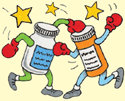Certain Anti-Seizure Drugs Up the Risk of HIV Treatment FailurePrevious Comments:
June 14, 2011
People taking older anti-seizure medications that are broken down by the same liver enzyme (CYP3A4) as many common antiretroviral (ARV) drugs were more likely to experience treatment failure than people taking seizure medications that aren’t broken down by that liver enzyme. These data were published online May 16 in the journal AIDS Research and Therapy.
A significant minority of people with HIV use anti-seizure medications. Roughly 11 percent of all HIV-positive individuals are diagnosed with a seizure disorder, and a substantial number of additional people use the same class of drugs for other disorders, including neuropathic pain, bipolar disorder and depression.
Though FDA guidelines recommend against combining—or urge caution when combining—some of the older anti-seizure drugs with ARV therapy, not all people have the option of the newer medications. For some people this is because the new medications don’t control their seizure disorders well, or because they can’t tolerate the newer drugs. The lack of available alternative drugs in resource-poor settings is another common reason why people with HIV still use them.
The problem with these older anti-seizure drugs is that they are broken down by the liver enzyme CYP3A4. This enzyme is also required to break down protease inhibitors such as Prezista (darunavir) as well as non-nucleoside reverse transcriptase inhibitors such as Sustiva (efavirenz) and the entry inhibitor Selzentry (maraviroc). This means that people who combine the anti-seizure drugs with their HIV therapy might be at higher risk of HIV treatment failure.
To study how a group of older anti-seizure drugs—including Dilantin (phenytoin), Tegretol (carbamazepine) and Luminal (Phenobarbital)—affects ARV treatment, Jason Okulicz, MD, from the Uniformed Services University of the Health Sciences in Bethesda, Maryland, and his colleagues studied the medical records of a group of HIV-positive people enrolled in the U.S. Military HIV Natural History Study.
Okulicz and his colleagues compared the rates of treatment success in 19 HIV-positive people taking the older anti-seizure drugs, with 85 people taking new anti-seizure drugs and 190 people taking no seizure medication. The research team only included people taking anti-seizure medication for either a seizure disorder or neuropathy.
The groups were similar in most respects, except that those taking the older anti-seizure medications were more likely to have a seizure disorder and those taking the newer medications were more likely to have neuropathy. The criteria for a person to be defined as having treatment failure included having no viral load measures under 400 copies within the first six months after starting ARV therapy, or having at least two measurements above 400 copies after the first six months of therapy.
Okulicz’s team found that treatment failure was more than four and a half times more common in people taking the older anti-seizure medication. This difference held up even when the team accounted for differences in viral load before starting therapy and the year in which people started therapy. The difference between people on the older anti-seizure drugs and those taking no anti-seizure medication was less meaningful, however. People on the older anti-seizure medications were only significantly more likely to experience treatment failure than those taking no anti-seizure medication when pre-treatment viral loads were taken into account.
“[Older anti-seizure medications] should be avoided in favor of [newer medications] in patients requiring concurrent [ARV treatment] and [anti-seizure] therapy due to the higher potential of virologic failure and reduced efficacy,” conclude the authors, who added, “In areas where [older anti-seizure medication] use cannot be avoided, closer and more frequent monitoring of HIV and seizure control is warranted.”
comments 1 - 3 (of 3 total)
David Evans, AIDSmeds, New York, NY, 2011-06-23 15:55:37
While there was a difference in the risk of treatment failure between those on older versus newer anti-seizure meds, there was less difference between those NOT taking seizure meds and those taking older-seizure meds. The authors don't provide an explanation, but argue that there may have been more significant differences in terms of baseline viral load and and adherence between those on and off seizure meds compared with the two groups that were both taking seizure meds.
Steven McLaughlin, Washington, DC, 2011-06-17 12:55:25
This article is poorly written and provides no meaningful data. In the 8th paragraph the author states that the individuals taking the older seisure meds were 4.5X more likely to have treatment failure and then in went on to say,"The difference between people on the older anti-seizure drugs and those taking no anti-seizure medication was less meaningful, however." The author tried to identify patterns but did not clearly establish a causal relationship between the 3 groups of test subjects.
jjbearphx, Phoenix, 2011-06-16 11:37:22
I have HIV induced eplepsy. My experience is not failure to maintain viral suppression, but failure of the anti seizure meds Dilantin then Zonigram was added and that has causes exacerbation of neuropathy. Hideous AM Med Hang over, that doubles after my AM antiviral pass as liver dumps toxins to work on HIV meds. Anti Epileptics aren't covered on ADAP formularies end up o o pocket, new anti seiz drugs are expensive. Lack of access to epileptologists makes things harder all around. not covered
http://www.aidsmeds.com/articles/hiv_seizure_protease_1667_20615.shtml

No comments:
Post a Comment
All comments welcome but advertising your own service or product will unfortunately result in your comment not being published.